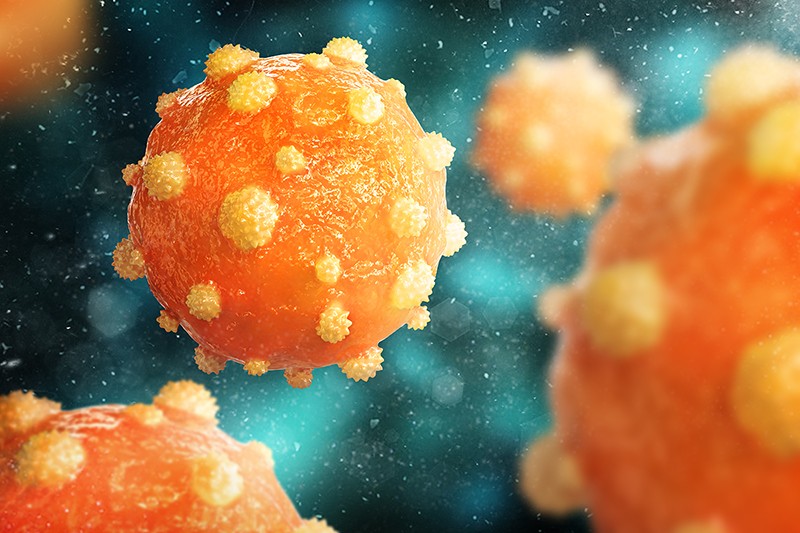Approved treatments for chronic infections of hepatitis B virus (HBV) are currently limited to two main types: injections of interferon, a substance normally produced by the immune system to fight infections, and nucleoside or nucleotide analogues (NUCs). NUCs are well-tolerated drugs that can be taken orally to potently suppress virus replication, and are the main therapy for chronic HBV in most countries. In a similar way to anti-HIV drugs, however, NUCs seldom eradicate the virus, forcing people with HBV to have lifelong treatment to prevent dangerous recurrences of liver disease1.
A prevailing dogma in the HBV field has been borrowed from studies of other chronic infections. It asserts that reducing viral antigens in the blood or liver — especially the hepatitis B surface antigen, or HBsAg — might awaken immune cells called T cells so that they will fight the virus and clear the chronic infection2. Accordingly, several therapeutic approaches that either reduce levels of viral antigens in the circulation or decrease their production in the liver have already reached the clinic, both alone and in combination with NUCs or interferon1.
But recent findings are casting doubt on this strategy. Indeed, studies in the past two years have demonstrated that HBsAg levels in the circulation do not affect the magnitude or the function of T cells that could tackle HBV3,4. Moreover, research in mice has shown that removing HBsAg from the blood does not improve the function of T-cell responses that are specific to HBV5. Reducing the production of viral antigens in the liver might not work, either — mouse experiments that decreased antigens on liver cells by up to 50-fold failed to elicit T-cell responses that had potential antiviral activity6,7. On this basis, we predict that antigen-reduction strategies will, at best, provide only partial or transient restoration of the immune system in people with chronic HBV, rather than eradicating the virus.
We therefore think that reducing antigens is not enough to provoke significant immune control of persistent HBV infection. To develop a therapy that is effective against chronic HBV, it will be necessary to consider immune-stimulating approaches that take into account several key peculiarities of the environment and conditions in which HBV persists.
The first of those peculiarities is the porous blood supply in the liver, through which about one-third of all blood cells move slowly every minute. This helps circulating T cells to recognize HBV antigens on underlying liver cells easily, even without exiting the blood vessels6.
A second peculiarity is that when T cells reach the liver and recognize HBV antigens on liver cells for the first time, they typically become incapable of fighting the virus. This happens because the liver cells fail to provide the T cells with specific signals for activation and differentiation6. This unresponsiveness is also thought to be why HBV and other viruses that affect mainly the liver, such as hepatitis C, are able to establish lifelong infections.
Third, the long duration of HBV infection, often spanning decades, seems to weaken the antiviral potential of HBV-specific T cells3. Indeed, this persistence has a greater effect on the course of the disease than does the relative abundance of circulating and liver antigens.
These peculiarities suggest other ways to develop therapies for HBV. For instance, the use of therapeutic vaccines might stimulate professional antigen-presenting cells (such as dendritic cells) to take up HBV antigens and migrate to lymph nodes draining the injection area. There, dendritic cells might provide HBV-specific T cells that have not encountered antigens (known as naive T cells) with the activation signals that liver cells cannot supply, allowing ‘effector’ T cells to differentiate, travel to the liver and fight HBV. In another approach, therapeutic vaccines could be combined with immune-system modulators in a manner that would enable naive T cells to receive appropriate signals from specialized liver cells called Kupffer cells. This could be particularly helpful for naive T cells that reach the liver before they have encountered vaccine-generated antigens. Lastly, therapeutic vaccines and immunomodulators might work best in young people with HBV, in whom the number and function of HBV-specific T cells are not reduced by prolonged antigen exposure, unlike in adults8.
Combining antigen-reducing approaches with therapeutic vaccines has yielded promising results in preclinical models7. The same is true for the use of immunomodulators such as interleukin-2, which allow naive T cells to acquire potent antiviral activity after recognizing antigens on a specific subset of Kupffer cells6,9. Thus, long-term suppression and immune control of HBV infection could well require a combination of therapeutic vaccines and immunomodulators with direct-acting antivirals — not just approved NUCs, but also the capsid-assembly inhibitors that are emerging as potent weapons against HBV.
Complex combination therapies are extremely difficult to develop, because of safety and regulatory issues as well as high costs. It is therefore paramount that ongoing clinical studies of antigen-reducing drugs are assessed carefully and quickly. This will allow us to seize the opportunity to design new and more scientifically sound combinations to fight this vexing virus.
Competing Interests
Table of Contents
M.I. and L.G.G. are co-inventors on several patents (Patent appl. No. 20156716.1; Patent appl. No. 141758; Patent appl. No. 1907493.9; WO2020/234483; WO2020/030781; WO2020/016427; WO2020/016434) covering two potential interventions for the cure of chronic hepatitis B: first, the discovery of novel antivirals and, second, the idea of utilizing gene-therapy-based approaches to deliver a specific immunomodulator (IL-2) to the liver.

